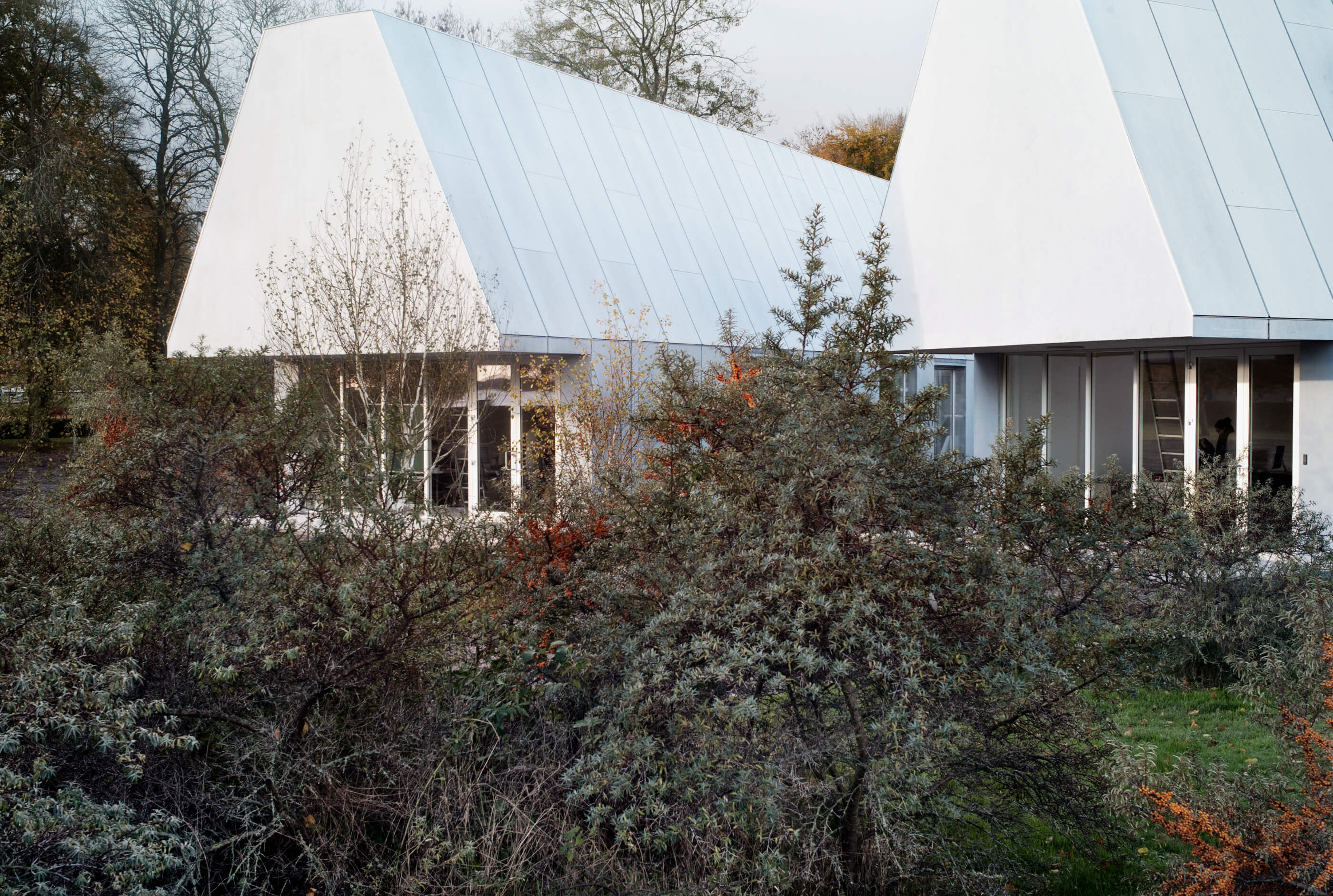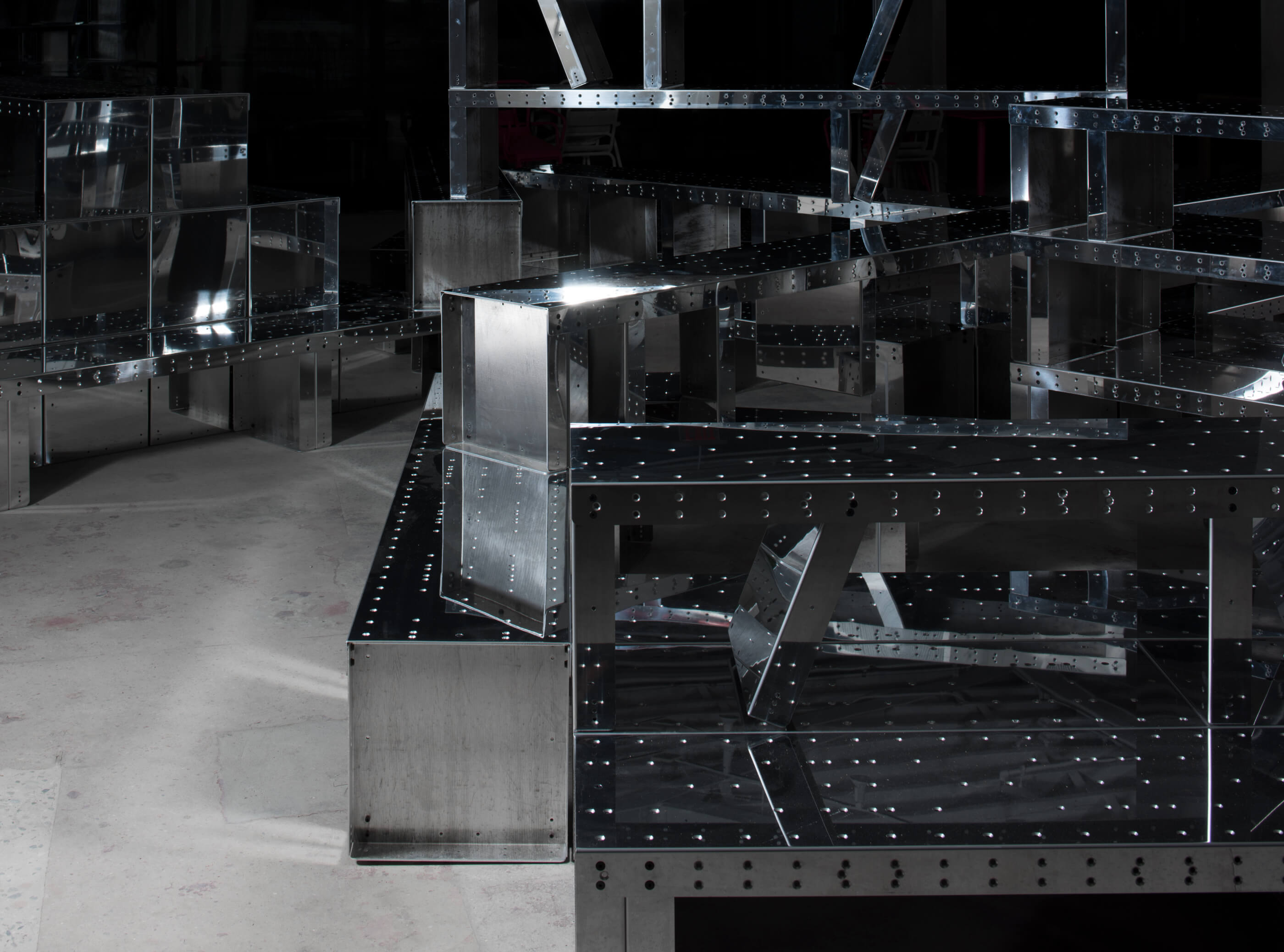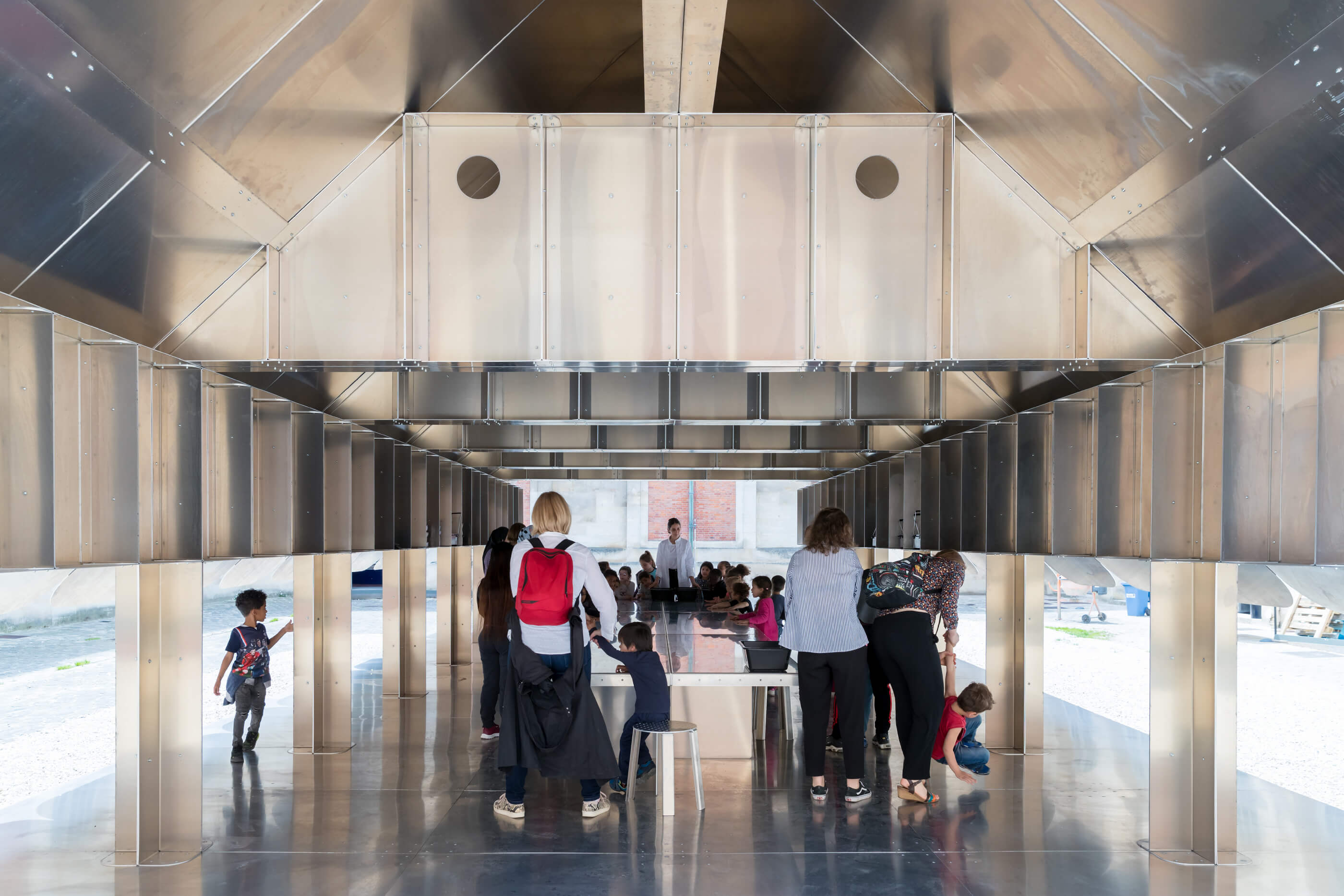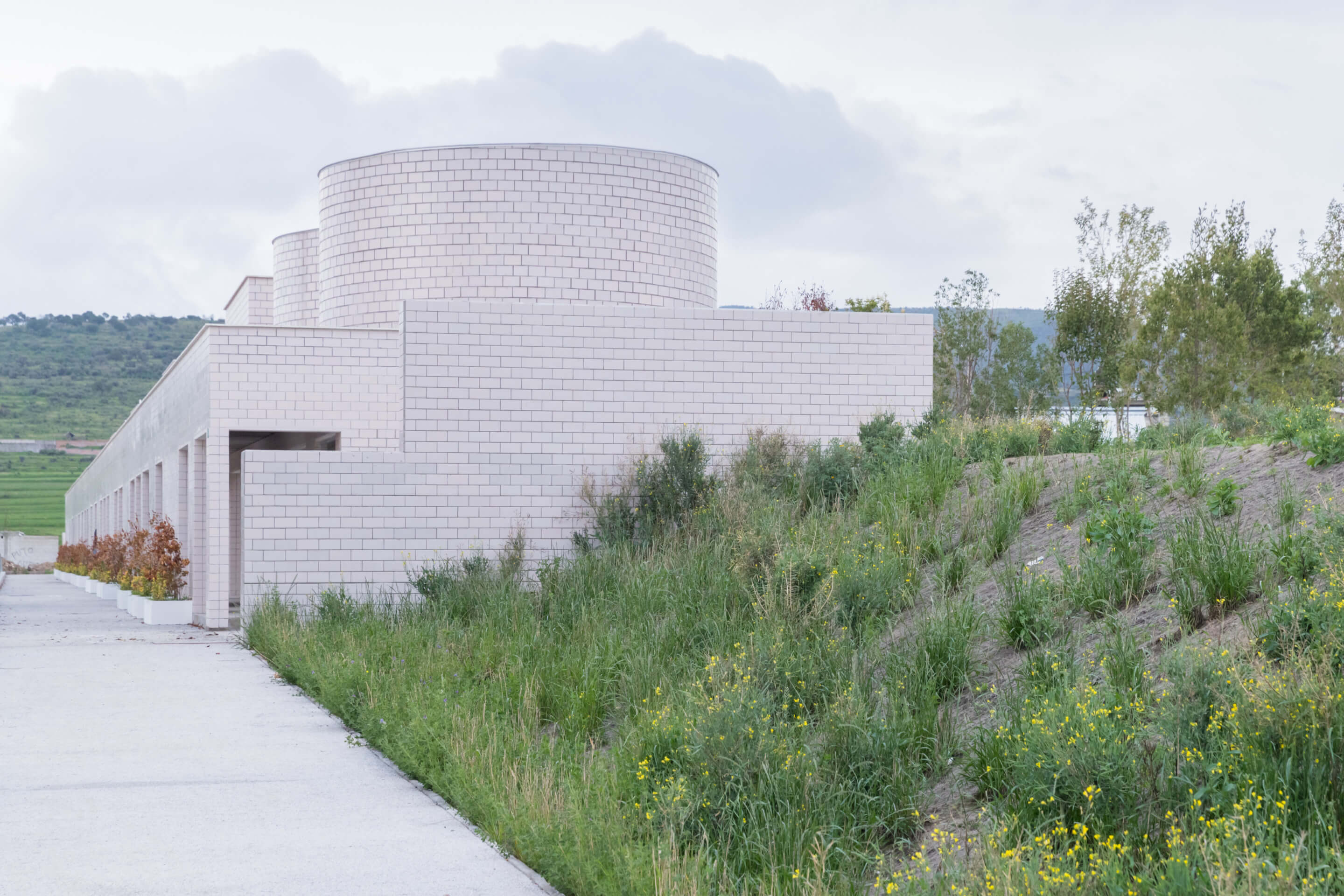The work of MOS easily appeals. Much of the attraction has to do with the design vocabulary that Hilary Sample and Michael Meredith have cultivated since forming the architectural studio in 2003. Straightforward and playful, but also painfully aware of itself, MOS’s visual language endears because it captures—anticipated?—a certain cultural mood whose antecedents lie in the 1990s. It’s trendy, fashionable without being disposable (for now), basic as in basics. There is also evidence of humor of the wry-and-dry variety, though the work might be too self-involved to ever really be funny. Probably for the best, as architecture is not a medium well-suited to comedy.
Repetition, or the resignation to it, is another conspicuous feature, as is clear in the assorted gables, chimneys, primitive solids, and parallelepipeds that recur, and quite literally pile up, in MOS’s catalog. We might chance that it’s this same Freudian analytic that underlay Sample and Meredith’s early desire for MOS “to be horizontal and fuzzy, as opposed to tall and shiny”—horizontal as in supine. It also alters how their work, a mix of built and unbuilt architectural projects and multimedia installations, is received. The immediacy that draws observers in develops, upon further observation, into a palpable strangeness. Sharply defined, “hi-res” geometries begin to soften and blur at the edges, while solid volumes are revealed to be thin envelopes. As Sample put it to AN: “Simple, straightforward things can produce unexpected things.”
But though they are committed to expanding the limits of practice, she and Meredith are, first and foremost, architects. The goal is not merely to produce work that is visual, or even spatial, but also economical, Sample said. “That’s an internal goal we set for ourselves. But it helps in designing a building. We want it to be very clear to someone looking at one of our [buildings] how it comes together. It’s not a mystery.”
Some might argue that projects such as Petite École, a one-room nursery school without walls, or Laboratorio de Vivienda, a welcome pavilion (only partially closed and conditioned) for a low-income housing complex in Mexico, could stand to benefit from a little more mystery or sleight of hand. Both offer shelter in an elemental sense that, depending on the angle of observation, appears provisional. But this view would reveal more about an anxiety at the core of the discipline than anything about MOS’s idiosyncratic tendencies. Architecture, and most architects, insist on control, even if the rhetoric of contingency has become incorporated into its discourse. “We’re accustomed to thinking of architecture as a closed space,” Sample said. “We want closed windows and doors, [to] make sure the sealants are tight to keep water out, weather stripping—all important considerations. But the conversation is exclusively about those as opposed to how we open things up.”
If MOS pursues an agenda of open-endedness, it often does so literally. The design of the following projects, Sample said, “does not constrain the function of their spaces. Instead, they offer up exposure to the outside.” Courtyards and gardens are treated as catalysts, which draw architectural volumes into close—sometimes awkwardly close—relation. She hopes that the experiences of the past year, both of lockdown and of remote work and study, have instilled a “ruggedness” in people so that “we don’t always need to be in air-conditioned spaces where things are so controlled. That would be a wonderful outcome from all of this.”
School No. 1: Krabbesholm Højskole campus, 2012

MOS’s work is, to a great degree, preoccupied with narratives of art and art-making. For the Krabbesholm Højskole, an arts high school in Skive, Denmark, Sample and Meredith concentrated the art, architecture, graphic design, and photography studios on a single site. Each discipline is given its own building volume, though in material (the outer shell comprises industrial cement rainscreen panels) and form (linear and with high-pitched roofs) they are nondescript. Linked at the corners by covered patios and a central courtyard, the buildings form a small community. Large windows ensure that “everyone can see into and out of the buildings and know what everyone is working on,” said Sample.
Installation No. 15: And Benches, Platforms, Partitions, Shelving, Activity Books, Uniforms, 2016

As the first part of this work’s name indicates—following a numerical convention that MOS maintains in its books and website and reproduced here—the office has done a lot of installation work. The second half of the name suggests its use, which was evidently manifold. Conceived for the now-defunct Brooklyn art space A/D/O, And Benches… comprised vertical and horizontal elements that could be stacked into stadium risers, laid adjacently to form a platform, or made into shelving, among other configurations. A cast of gallery attendants and volunteers, wearing reflective uniforms that matched the finish of the componentry, periodically manipulated the installation’s shape.
School No. 3: Petite École, 2019

Though humble in scale, this open-air classroom for a school in Versailles, France, encapsulates much of MOS’s thinking. The project has the virtue of an aperçu, and illustrates, Sample said, just how little architecture needs in order to be architecture. “At Petite École, you just need a table, some chairs, and coverage,” and nothing else, not even walls. Of course, MOS designed that table and those chairs using the same folded aluminum that makes up the columns, roof, and stacked beams. Light yet durable, the various constitutive elements can be recycled or reassembled elsewhere. The simplicity of the construction and its inviting pose (the eaves “droop” like the ears of a basset hound) are teachable moments in themselves.
Housing No. 8: Laboratorio de Vivienda, 2019

The phrase “laboratory for living” is bound to excite no one except architects (and, perhaps, the venal rich who make use of them). But this 32-building complex currently under construction in Apan, Hidalgo, Mexico, promises to be different. Meant for low-income residents, the dwellings take cues from the vernacular traditions of Mexico’s nine climatic zones. MOS provided the master plan and helped to curate the roster of architects charged with the individual housing designs, which both celebrate and reformulate the terms of low-income housing. Sample and Meredith also contributed an entrance pavilion at the east of the site. The linear multipurpose building, which contains classrooms and other community spaces, forms the only edge of the otherwise-fenceless development. In the plan, the compact, autonomous houses appear scattered, pell-mell, in a vast garden laboratory. Here, pedestrian pathways, outdoor furniture, and trees form the basis of community, with architecture stepping into the role of giant garden gnomes.











